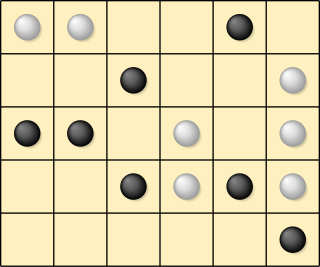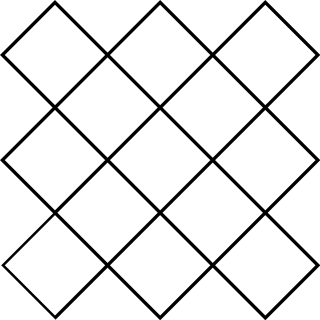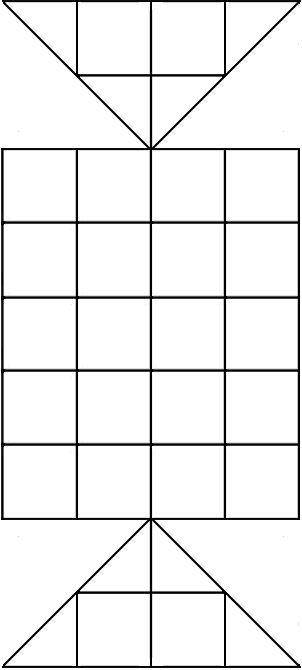| Genres | Board game Abstract strategy game |
|---|---|
| Players | 2 |
| Skills | Strategy, tactics |
Choko is a two-player abstract strategy board game from Gambia Valley, West Africa. It is played specifically by the Mandinka and Fula tribes. It is related to Yote.
| Genres | Board game Abstract strategy game |
|---|---|
| Players | 2 |
| Skills | Strategy, tactics |
Choko is a two-player abstract strategy board game from Gambia Valley, West Africa. It is played specifically by the Mandinka and Fula tribes. It is related to Yote.
The goal of choko is for a player to capture all the pieces of an opponent.
5 x 5 holes set in the ground or on a board. Each player has 12 pieces. One plays the white pieces, and the other plays the black pieces; however, any two colors or distinguishable objects will suffice.
1. The board is empty in the beginning. Players decide what colors to play, and who starts first. Players alternate their turns.
2. Players first drop their pieces. They drop one piece per turn.
3. The first player drops their first piece anywhere on the board. The first player has the drop initiative. It is not necessary to drop on every turn, but as long as the first player continues to drop, then so does the second player.
If the first player decides to make a move (non-capturing move or capturing move), then the second player has the option to drop or move. If the second player decides to drop, then he or she has the drop initiative until he or she decides to move. This means that the first player must continue to drop as long as the second player continues to drop.
However, if the second player had made a move instead, then the first player has the option to drop or move, and has the drop initiative.
4. In a non-capturing move, pieces can move orthogonally one space per turn. Only one piece can be moved per turn.
5. In a capturing move, pieces capture similarly as in Draughts by the short leap, except they must capture orthogonally (not diagonally). The player's piece must be adjacent to the enemy piece, and leap over it onto a vacant space on the other side. Only one leap is allowed, and therefore only one capture by this method is allowed. The player, however, is to take another enemy piece from anywhere on the board. Therefore, in a capturing move, two enemy pieces are taken each time.
6. After all pieces have been dropped, the second player moves first.
Baroque chess is a chess variant invented in 1962 by Robert Abbott. In 1963, at the suggestion of his publisher, he changed the name to Ultima, by which name it is also known. Abbott later considered his invention flawed and suggested amendments to the rules, but these suggestions have been substantially ignored by the gaming community, which continues to play by the 1962 rules. Since the rules for Baroque were first laid down in 1962, some regional variation has arisen, causing the game to diverge from Ultima.
Mak-yek is a two-player abstract strategy board game played in Thailand and Myanmar. Players move their pieces as in the rook in Chess and attempt to capture their opponent's pieces through custodian and intervention capture. The game may have been first described in literature by Captain James Low a writing contributor in the 1839 work Asiatic Researches; or, Transactions of the Society, Instituted in Bengal, For Inquiring into The History, The Antiquities, The Arts and Sciences, and Literature of Asian, Second Part of the Twentieth Volume in which he wrote chapter X On Siamese Literature and documented the game as Maak yék. Another early description of the game is by H.J.R. Murray in his 1913 work A History of Chess, and the game was written as Maak-yek.
A fairy chess piece, variant chess piece, unorthodox chess piece, or heterodox chess piece is a chess piece not used in conventional chess but incorporated into certain chess variants and some chess problems. Compared to conventional pieces, fairy pieces vary mostly in the way they move, but they may also follow special rules for capturing, promotions, etc. Because of the distributed and uncoordinated nature of unorthodox chess development, the same piece can have different names, and different pieces can have the same name in various contexts. Most are symbolised as inverted or rotated icons of the standard pieces in diagrams, and the meanings of these "wildcards" must be defined in each context separately. Pieces invented for use in chess variants rather than problems sometimes instead have special icons designed for them, but with some exceptions, many of these are not used beyond the individual games for which they were invented.

Yoté is a traditional strategy board game of West Africa, where it is a popular gambling game due to its fast pace and surprising turnarounds. A player wins by capturing all opposing pieces. Yoté is related to the game Choko.
Permainan-Tabal is a two-player abstract strategy board game from Indonesia. The game is sometimes referred to as a cross between Alquerque and Draughts. It is essentially Draughts played on an expanded Alquerque board. It is especially similar to Draughts in that the moves of the pieces are strictly forward and sideways until they are promoted to Kings by reaching the other player's first rank. The game is also referred to as Dama.

Kōnane is a two-player strategy board game from Hawaii. It was invented by the ancient Hawaiian Polynesians. The game is played on a rectangular board. It begins with black and white counters filling the board in an alternating pattern. Players then hop over one another's pieces, capturing them similar to checkers. The first player unable to capture is the loser; their opponent is the winner.
Ming Mang is a two-player abstract strategy board game from Tibet. Ming Mang is also a general term for the word "boardgame" in Tibet. The correct name and spelling of the game may actually be Mig Mang(s), but pronounced Ming Mang or Mi Mang. The term Mig Mang is also applied to Tibetan Go with both games using exactly the same board which is a 17 x 17 square board, and black and white pieces. Mig is in reference to the chart of the board, and Mangs refers to the notion that the more charts are used on the board, the more pieces are needed to play the game, but some state that it means "many eyes". The game may also be known as Gundru. The game was popular among some Tibetan monks before the Chinese invasion of Tibet in 1950, and the uprising in 1959, and among aristocratic families.

Buga-shadara, also known as Bouge Shodre, is a two-player abstract strategy board game from Tuva, a republic in Siberia, Russia. It is a hunt game where one player plays the deer. There are two deer usually represented as the black pieces. The boars are also referred black in the referenced article "Buga-shadara a folk game from Tuva". The other player has 24 white pieces with dogs associated to them. The board consist of an Alquerque board flanked on two of its opposite sides by a square patterned board. Because the board is in part an Alquerque board, this makes Buga-shadara a tiger hunt game. What makes Buga-shadara unique among tiger games are the expansion boards on the two opposite sides of the Alquerque board. They are square, whereas most are triangle-like. The word "shadara" resembles the word "shahdara". The "shah" part "is a title given to the emperors/kings and lords of Iran .". There is a place called Shahdara Bagh in Lahore, Punjab, Pakistan, and it's thought that the word "Shahdara can be translated as "the way of kings". Shah translates as "king" and dara translates as the way of kings." The referenced article associates the boars as kings. Perhaps the boars or deer are kings, and have to find a way or have a way with the white pieces or dogs.
Felli is a two-player abstract strategy board game from Morocco. It is related to Alquerque and draughts as pieces leap over one another to capture. Felli's closest relatives are several thousand miles away in the form of Lau kata kati from India and the game called Butterfly from Mozambique. One main difference is that the Felli board has only one horizontal line across its breadth as opposed to two found in the other two games.
Jul-Gonu is a two-player abstract strategy board game from Korea. It is one of many Gonu games. The game has a relatively small board, and yet offers a challenge at different levels. The game could be played on a larger board, however, it tends to be tiresome. Jul means "lines", and the lines of the board are often drawn on the ground. The game is also referred to as "Ne-Jul-Gonu", i.e. "Four Lines Gonu", referring to the four lines in each direction.

Liberian Queah is a two-player abstract strategy game from Liberia. It is specifically from the Queah tribe. The game is played on a slanted or diagonal square board with only 13 spaces. Pieces move "orthogonally" along these slanted or diagonal square boards. Another unique feature is that each player must have four pieces on the board. Each player's captured piece is resupplied at the beginning of their next turn with a piece from their reserve.
Wali is a two-player abstract strategy game from Africa. It is unknown specifically which African country the game originates from. Players attempt to form a 3 in-a-row of their pieces, and in doing so capture a piece from their opponent. The game has two phases: Drop Phase and Move Phase. Players first drop as many of their pieces as possible in the Drop Phase, then move them to form 3 in-a-rows which allows them to capture the other player's pieces in the Move Phase.
Leap Frog, also known as Leapfrog, is a multi-player abstract strategy board game that was described by H.J.R. Murray in A History of Board Games Other Than Chess (1898) and attributes its origin to England. Several variants have been created including one by Murray himself which utilizes different colored pieces with different point values. Several players can participate. In the traditional game, players take any piece on the board and use it to hop over and capture other pieces on the board. When no more pieces can be captured, the game ends, and the player with the most pieces wins the game. Murray includes it in the section called Clearance Games which includes the game Solitaire which it does resemble in many ways except that Solitaire is played by only one person.

Kharbaga is a two-player abstract strategy game from North Africa. In a way, it is a miniature version of Zamma; however, there are more diagonal lines per square on the board as compared to Zamma. The game is considered part of the Zamma family. The game is also similar to Alquerque and draughts. The board is essentially an Alquerque board with twice the number of diagonal lines or segments allowing for greater freedom of movement. The initial setup is also similar to Alquerque, where every space on the board is filled with each player's pieces except for the middle point of the board. Moreover, each player's pieces are also set up on each player's half of the board. The game specifically resembles draughts in that pieces must move in the forward directions until they are crowned "Mullah" which is the equivalent of the King in draughts. The Mullah can move in any direction.
High Jump is a two-player strategy board game from Somalia. It is related to draughts and Alquerque as pieces hop over one another for capture; however, pieces move and capture orthogonally and not diagonally. Moreover, the game is played on a 5×5 square board. A feature of High Jump is that the central square offers a kind of sanctuary; a piece occupying the central square cannot be hopped over and captured. The same board is used in the game Seega.
Awithlaknannai Mosona is a two-player strategy board game from the Zuni Native American Indian tribe of New Mexico, United States. It is unknown how old the game is. The game was described by Stewart Culin in his book "Games of the North American Indians Volume 2: Games of Skill" (1907). In this book, it was named Awithlaknan Mosona. Awithlaknannai Mosona resembles another Zuni board game called Kolowis Awithlaknannai with few minor differences. The former having a smaller board, and depending upon the variant, it also has less lines joining the intersection points. The rules are the same. Awithlaknannai Mosona belongs to the draughts and Alquerque family of games as pieces hop over one another when capturing. It is actually more related to Alquerque, since the board is made up of intersection points and lines connecting them. It is thought that the Spanish had brought Alquerque to the American Southwest, and Awithlaknannai Mosona may have been an evolution from Alquerque. However, in Stewart Culin's 1907 book, the Zunis claim that they had adopted a hunt game from Mexico similar to Catch the Hare and the Fox games of Europe, and transformed it into Awithlaknannai Mosona. In these games, one player has more pieces over the other, however, the other player's piece has more powers. The Zuni's equalized the numbers of pieces and their powers, and also may have transformed the board making its length far exceed its width. Diagonal lines also replaced orthogonal lines altogether. However, the hunt game from Mexico may have used an Alquerque board even though the game mechanics of their new game, Awithlaknannai Mosona, were completely different.
Tiger and buffaloes is a two-player abstract strategy board game from Myanmar. It belongs to the hunt game family. The board is a 4x4 square grid, where pieces are placed on the intersection points and move along the lines. It is one of the smallest hunt games. Three tigers are going up against eleven buffaloes. The tigers attempt to capture as many of the buffaloes by the short leap as in draughts or Alquerque. The buffaloes attempt to hem in the tigers.
Dala is a two-player abstract strategy board game from Sudan, and played especially by the Baggara tribes. The game is also called Herding the Cows. It is an alignment game with captures similar to that of the game Dara. Players first drop their pieces onto the board, and then move them orthogonally in an attempt to form 3 in-a-rows which allows a player to capture any of their opponent's piece on the board.
Sua Ghin Gnua is a two-player abstract strategy board game from Thailand, formerly known as Siam. Another name for the game is Tigers and Oxen. It is a hunt game played on a 5x5 square grid with only orthogonal lines. One player plays the three tigers, and the other player plays the twelve oxen. The board is empty in the beginning. Players first drop their pieces onto the board, and then are able to move them. The tigers can capture the oxen by the short leap as in draughts and Alquerque, but the oxen attempt to elude and at the same time hem in the tiger. Sua Ghin Gnua most resembles the tiger hunt games such as Bagh-Chal, Rimau-rimau, Main Tapal Empat, Catch the Hare, and Adugo since they all use a 5 x 5 square grid. But tiger games technically consist of a standard Alquerque board which is a 5 x 5 square grid with several diagonal lines criss-crossing through it which are completely missing in Sua Ghin Gnua. There are however some variants of Catch the Hare which have missing diagonal lines also. Another game that resembles Sua Ghin Gnua is from Myanmar called Tiger and Buffaloes which is a hunt game consisting of a 4 x 4 square grid with no diagonal lines. Myanmar happens to border Thailand geographically so there might be a historical connection between the two games. Another game from Myanmar is Lay Gwet Kyah that is presumed to be similar to Sua Ghin Gnua. Sua Ghin Gnua was briefly described by Stewart Culin, in his book Chess and Playing Cards: Catalogue of Games and Implements for Divination Exhibited by the United States National Museum in Connection with the Department of Archaeology and Paleontology of the University of Pennsylvania at the Cotton States and International Exposition, Atlanta, Georgia 1895 (1898). It's also briefly mentioned by H.J.R. Murray in his book A History of Chess (1913). It was also described by R.C. Bell, in his book Board and Table Games from Many Civilizations (1969).

Astar is a two-player abstract strategy board game from Kyrgyzstan. It is a game similar to draughts and Alquerque as players hop over one another's pieces when capturing. However, unlike draughts and Alquerqe, Astar is played on 5×6 square grid with two triangular boards attached on two opposite sides of the grid. The board somewhat resembles those of Kotu Ellima, Sixteen Soldiers, and Peralikatuma, all of which are games related to Astar. However, these three games use an expanded Alquerque board with a 5×5 square grid with diagonal lines. Astar uses a 5×6 grid with no diagonal lines.